Open-circuited CT can cause serious safety concerns like fire, electrocution, and protection failure. Therefore, you must ensure that CT secondary should always closed-circuited.
Let us understand the CT construction and its working principle to know why the CT must not be open-circuited.
Construction of Current transformer
The current transformer consists of an iron core upon which primary and secondary winding are wound. The primary winding of the transformer is connected in series with the load and carries the actual current flowing to the load. The secondary winding of CT is connected to a measuring device or a protection relay.
The number of secondary turns is proportional to the current flowing through the primary; i.e., the larger the magnitude of the current flowing through the primary, the greater the number of secondary turns.
Reead detailed artcile on: Current Transformer – Construction, Phasor and Errors
Working Principle of Current Transformer
The current transformer works on the principle of electromagnetic induction.
When alternating current flows in the primary winding of CT, the primary current generates a magnetic field (H= NI) in the core of CT.
The generated magnetic field sets up magnetic flux in the core. The magnetic flux links to the secondary winding of CT mounted around the core, and thus, linked flux induces a voltage in the secondary winding of CT.
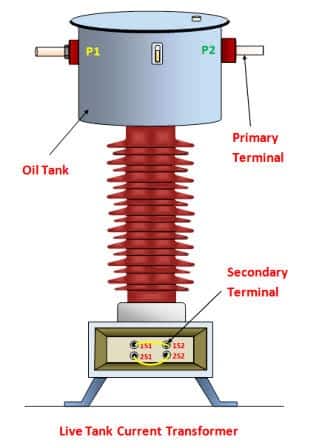
Read detailed artcile on: What is Magnetic Flux? Definition & Properties
How Closed CT Secondary Maintains Magnetic Balance
The secondary winding of CT is connected to the burden (measuring instrument or protective relay). If the secondary CT is connected to the burden, the alternating current starts flowing in the secondary winding of the transformer. The closed circuit CT diagram is shown in the below figure.
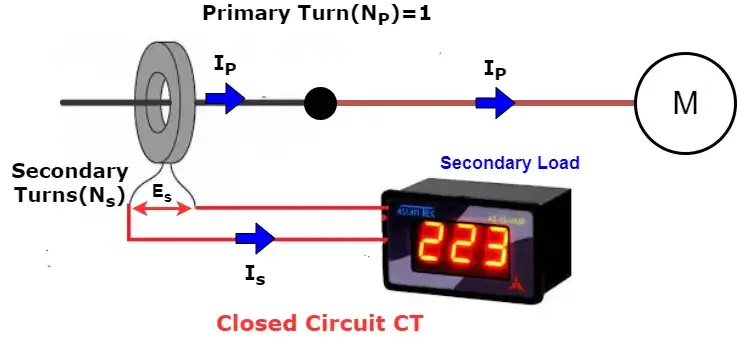
The current in the secondary winding creates an opposing magnetic flux that opposes the main flux created by the primary winding. The net flux in the core equals the difference between primary and secondary flux.
The flux in the core remains within the rated flux rating of the core when CT is connected to the specified burden.
What Happens If CT Secondary is Open?
It is very clear that the net flux in the core is equal to flux due to primary current minus flux due to secondary current.

If the open circuit CT is kept in operation, no current will flow in the secondary, and consequently, no secondary flux will be set up in the core.
The diagram of open circuited CT is shown below.
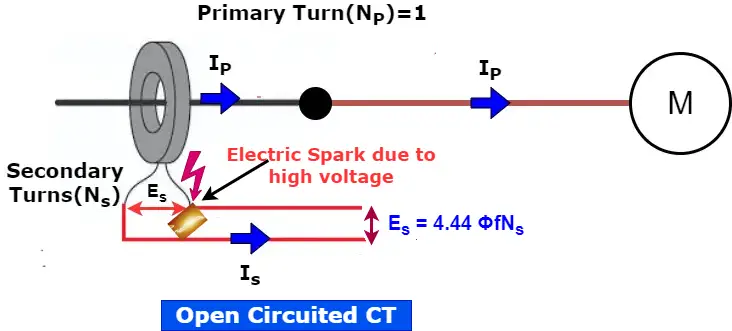
The net flux in the core of the CT is given in the following formula,
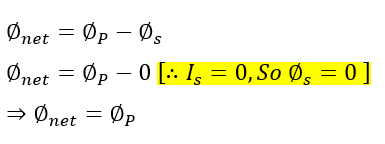
In the absence of a secondary current, the net flux will be higher than the flux generated in the core when CT is closed-circuited. The increased core flux induces more secondary voltage.
The CT secondary voltage depends on the core flux, and the output voltage can be expressed with the following mathematical expression.
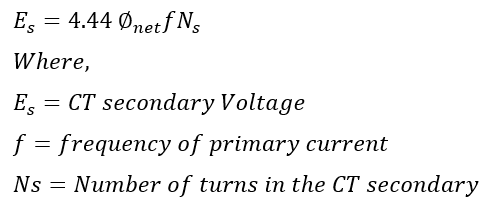
From the above expression, it is clear that the core carries higher flux during open-circuited CT, and as a result, a higher voltage is produced in the secondary.
The CT secondary can not sustain the voltage more than its designed rated voltage, and it causes insulation failure of the winding. Also, this high voltage may cause an electric shock to the person working in the feeder. The magnitude of the secondary voltage with open secondary may be kilovolts.
When the CT of the secondary is open, the CT VA is consumed in core heating as a core loss. As per the energy conservation law, the energy balancing is always there; the VA consumed by CT is equal to the core loss of the CT when the secondary is open-circuited.
For this reason, CT should never be kept open-circuited. While working on measuring equipment like an energy meter, ampere meter, or protection relay, the CT must be short-circuited on the test terminal block (TTB).
Read detailed artcile on: What is CT VA & How to Calculate it?
Real-Life Example: Open CT Voltage Hazard
Let’s consider a CT with a 1000:1 ratio carrying 1000 A on the primary side.
If its current transsformer secondary is left open, the magnetic flux in the core increases sharply. This causes a dangerously high voltage to appear across the secondary terminals.
Depending on the CT’s design, core saturation level, and material, the voltage may rise from 2 kV to 5 kV — or even reach up to 100 kV in extreme cases.
In a U.S. manufacturing plant, a technician encountered a 3.4 kV surge on an open CT secondary, causing relay burnout and arc tracking in the panel.
This incident highlights how an open circuit CT can create a serious safety hazard for personnel and equipment.
Summary
CT safety practices apply globally. In U.S. electrical codes and IEEE guidelines, it’s emphasized that CT secondaries must never be left open during operation or testing.
The open-circuited CT causes-
- High voltage at its secondary side causes flashover and insulation failure, which in turn creates a fire hazard.
- High Flux in the core can damage the CT.
- The protection of the equipment does not remain intact.
- The person working on CT can get an electric shock.
Frequently Asked Questions( FAQs)
A current transformer’s (CT’s) secondary must always be short-circuited because, if left open, it produces dangerously high voltage. This can damage the insulation, cause flashovers, and pose a serious electric shock risk.
When the CT secondary is open, no opposing flux is produced, resulting in high magnetic flux in the core. This induces high voltage in the secondary winding, leading to overheating, insulation failure, and possible fire hazards.
Yes. An open-circuited CT compromises the accuracy of current measurement and may result in incorrect operation or total failure of protection relays and measuring devices.
If the secondary of a CT is open while the primary carries high current, the secondary voltage can reach several kilovolts — far exceeding the rated insulation limit.
Always ensure that the CT secondary is short-circuited at the test terminal block (TTB) before disconnecting any instrument connected to it. This avoids dangerous voltage buildup.
Related Articles:
- Core Balance Current Transformer(CBCT)
- Difference between Current Transformer(CT) & Potential Transformer(PT)
- Why PS Class CT is used for Differential Protection?
- Accuracy Limit Factor of CT
- Current Transformer – Construction, Phasor and Errors
- Instrument Safety Factor of Current Transformer
- Current Transformer Secondary Grounding
- Accuracy Class Of Current Transformer
- How to Calculate Knee Point Voltage of Current Transformer?
- What is CT Burden? CT Burden Formula
In potential transformer the load current flows in the secondary and primary, whereas the load current flow in primary of the CT. The load current does not flow in the secondary of the CT.
I want a copy of electrical topics, especially transformers
With my best regards